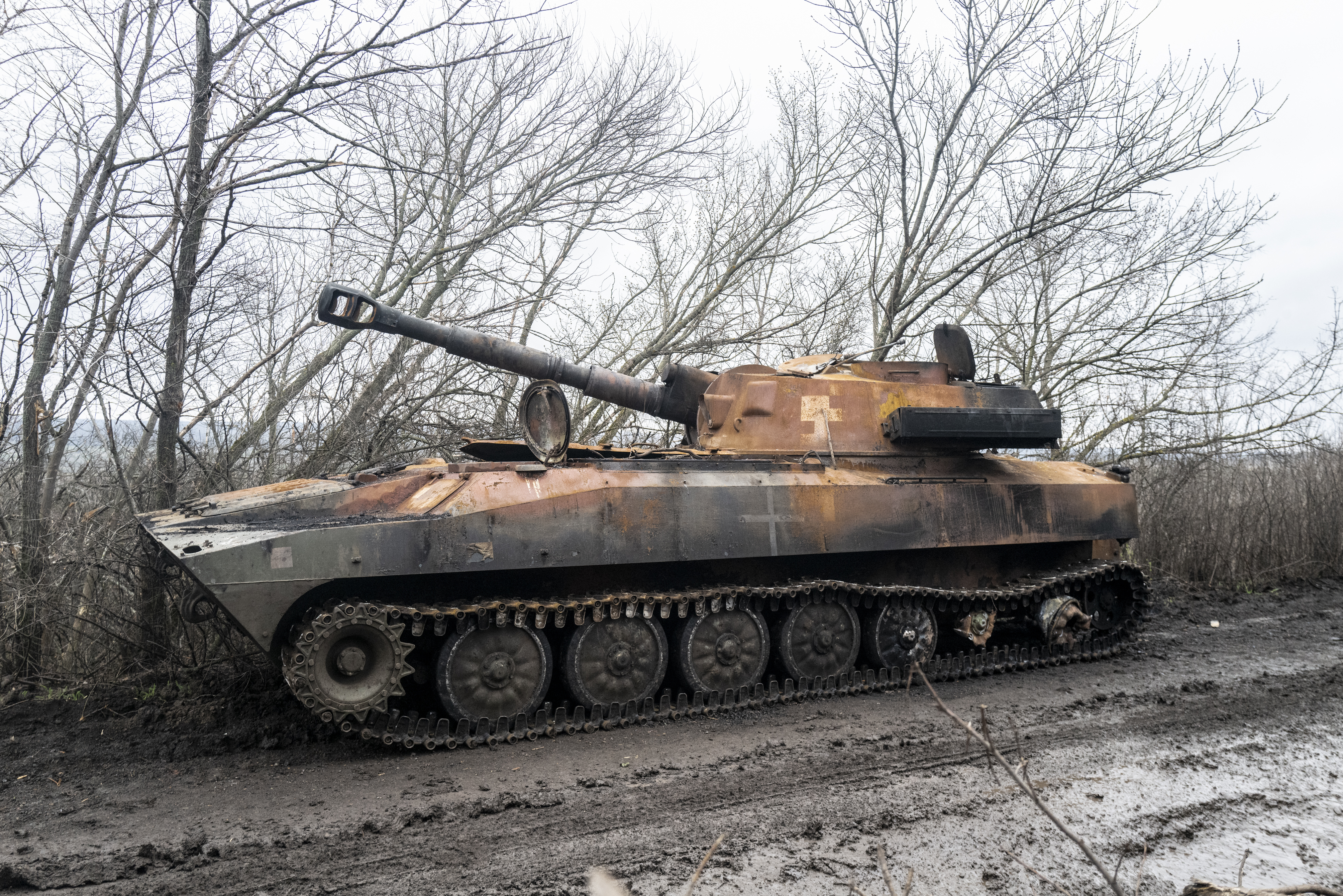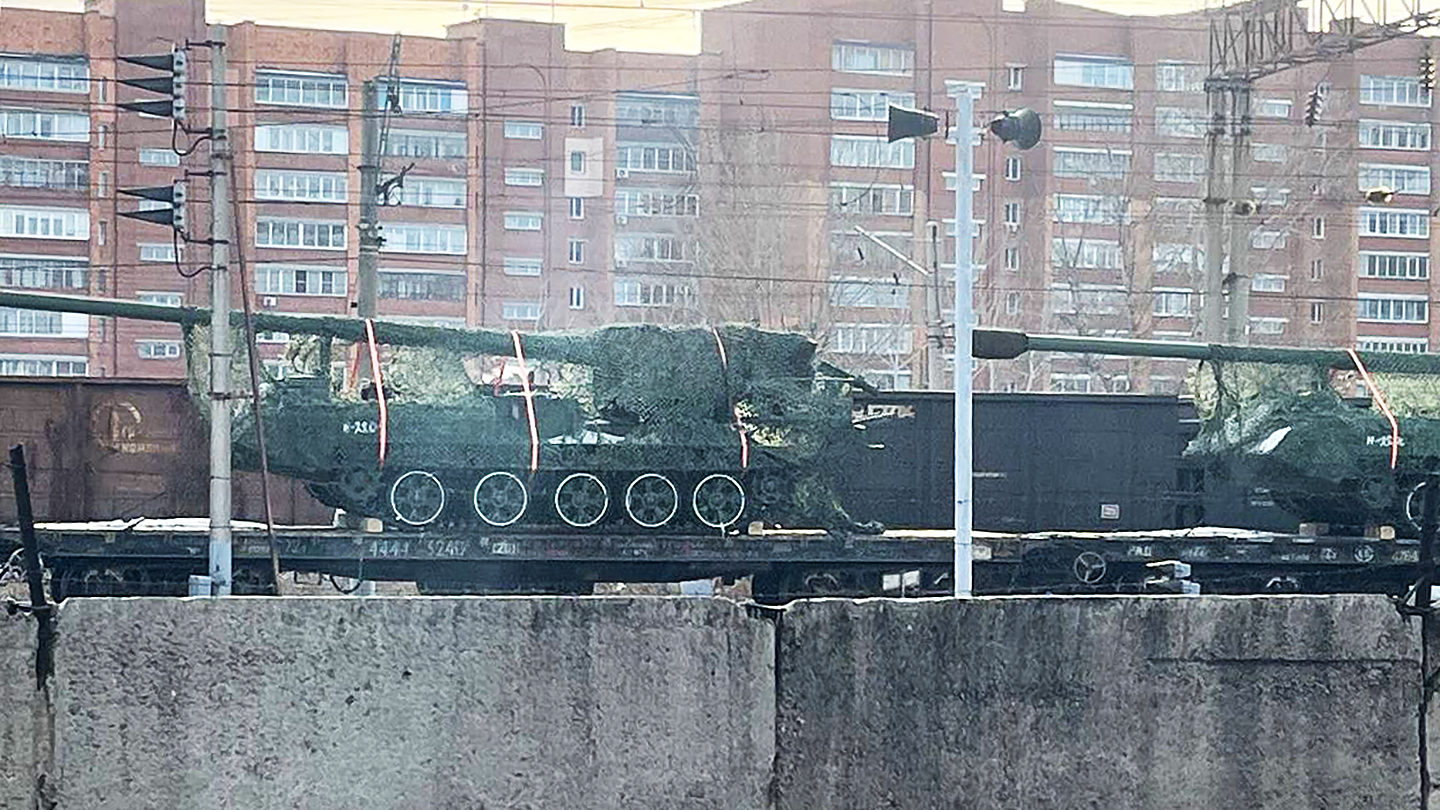A photo has emerged showing examples of a North Korean-made, self-propelled artillery system under transport in Russia, the clearest suggestion so far that Pyongyang is also now providing Moscow with these kinds of heavyweight, far-reaching artillery weapons for its war in Ukraine. That would hardly be a surprise at this point, with North Korea having supplied Russia with huge amounts of weaponry already, including millions of artillery rounds, as well as having committed to the deployment of thousands of troops for the conflict.
The photo in question appeared on social media today, apparently first being posted to the Russian Telegram messaging app. It shows at least two examples of 170mm M1989 Koksan self-propelled artillery units being transported on a flatbed railcar. Open-source intelligence analysts later geolocated this precisely to Krasnoyarsk, in central Russia. Notable is the fact the vehicles have white-painted roadwheels, a feature often seen on North Korean equipment during high-profile parades.
North Korea’s Koksan self-propelled artillery system was first fielded sometime in the late 1970s, as the M1978. The full Western designation indicates that it was first noted by intelligence agencies in 1978 in the city of Koksan.

The original M1978 is based on an adapted Type 59 tank, fitted with a 170mm caliber artillery cannon, mounted in an open superstructure rather than a protected turret. The M1989 version, as seen in the photo from Krasnoyarsk, uses the same gun but mounted on a more modern chassis, similar in appearance to that used on Russia’s 2S7 Pion, a 203mm self-propelled artillery piece. The M1989 version also has onboard storage for 12 rounds of ammunition.
The main advantage of the M1978/M1989 is its long range, with the big 170mm gun assessed as capable of firing a standard shell to a range of around 25 miles, or a rocket-assisted shell to a range of 37 miles. For a long time, the weapon was judged to be the longest-range conventional artillery piece in North Korean service.

Downsides include no ability to carry the gun crew, who have to be transported separately, and the lack of any armored protection for the crew once the gun is set up and in operation. Also, the rate of fire is incredibly slow by modern standards, just two rounds every five minutes. The German-made PzH 2000 self-propelled howitzer, also used by Ukraine, can fire 10 rounds per minute or a three-round burst in 10 seconds.
For Russia, there is also the issue that the M1989 uses 170mm ammunition, something that it doesn’t have in its own stocks, and which is, on a global scale, a relatively rare caliber. On the other hand, North Korea has plenty of ammunition that it could potentially supply.
It’s worth noting, too, that the M1978/M1989 is very much a known quantity to Western analysts. The weapon was exported to Iran and employed extensively in the Iran-Iraq War, some examples being captured and used by Iraq. The 2003 invasion of Iraq provided the U.S. military a chance to look at some of these weapons at close quarters.

We don’t know for sure at this point why the M1989 Koksan guns were in Russia, but there are several possible explanations.
They could be in Russia for test purposes, or even some kind of maneuvers involving North Korean troops.
Perhaps most likely, the guns could be headed to Ukraine, where Russia will use them to bolster its own self-propelled artillery units.
Finally, bearing in mind the increasing involvement of North Korean troops fighting for Russia, these weapons could also be headed to Ukraine, or the Kursk region of Russia, for use by Pyongyang’s own forces.
North Korea has huge quantities of Koksan and other large-caliber artillery, and Russia has been burning through its own stocks of such weapons, with questions about its war industry’s ability to replace them with the required urgency. You can read more about the major types of artillery that Russia began its full-scale invasion of Ukraine here.

There are also more than enough precedents for Russia wanting to acquire heavy weapons from North Korea, with long-range ones being of particular value. According to data from the Oryx open-source tracking group, at least 851 pieces of Russian self-propelled artillery have been destroyed, damaged, abandoned, or captured. The actual number is likely far higher as Oryx only tabulates losses that are visually confirmed using open-source materials.
Already, Pyongyang’s support for Moscow’s war in Ukraine has seen the supply of a diverse range of weapons, including millions of badly needed artillery rounds and various kinds of other ammunition.
A recent assessment from the South Korean National Intelligence Service (NIS), based on intelligence provided by the Ukrainian Defense Intelligence Directorate (GUR), listed North Korean weapons collected from the battlefield, including claimed “122mm and 152mm shells, Bulsae-4 anti-tank missiles, short-range ballistic missiles such as the KN-23, and RPG anti-tank rockets.”

“Considering the size of containers loaded on cargo ships traveling between North Korea and Russia, it appears that a total of more than eight million 122mm and 152mm shells have been provided to Russia so far,” NIS concluded.
Most recently, TWZ looked at claims that Russia may also have received North Korean Type 73 machine guns, although these could also be used by the thousands of troops that Pyongyang has now deployed to Ukraine.
As a result of the deepening military relationship between the two countries, there has also been speculation that North Korea could be set to benefit from Russian weapons and expertise. As well as suggestions that Pyongyang might receive new Russian combat aircraft to overhaul its badly aging air force, and there have also been concerns that Moscow might provide it with technologies to help accelerate its nuclear and long-range ballistic missile programs.

We may not have to wait long to see who ends up using the M1989 Koksan self-propelled artillery units in Ukraine — if indeed that’s where they’re headed. If they do end up at the front, whether used by Russian or North Korean forces, it would be bad news for Ukraine, which is already at a large artillery deficit compared to Russia.
Contact the author: thomas@thewarzone.com
